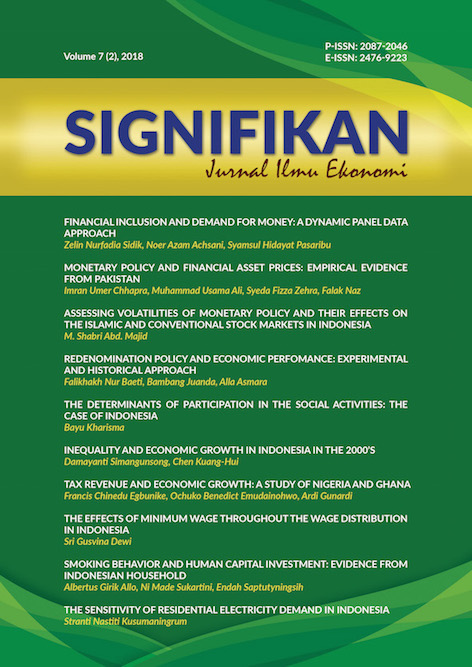The Effects of Minimum Wage Throughout the Wage Distribution in Indonesia
DOI:
https://doi.org/10.15408/sjie.v7i2.6125Keywords:
labor economics, minimum wage, wage distribution, unconditional quantile regression, formal and informal sectorsAbstract
The global financial crisis in 2007 followed by Indonesia’s largest labor demonstration in 2013 encouraged turmoils on Indonesia labor market. This paper examines the effect of the minimum wage on wage distribution in 2007 and 2014 and how the minimum wage increases in 2014 affected the distribution of wage differences between 2007 and 2014. This study employs recentered influence function (RIF) regression method to estimate the wage function by using unconditional quantile regression. Furthermore, to measure the effect of the minimum wage increase in 2014 on the distribution of wage differences, it uses the Oaxaca–Blinder decomposition method. Using balanced panel data from the Indonesian Family Life Survey (IFLS), it found that the minimum wage mitigates wage disparity in 2007 and 2014. The minimum wage policy in 2014 leads to an increase in the wage difference between 2007 and 2014, with the largest wage difference being in the middle distribution.
References
Alaniz, E., Gindling, T. H., & Terrel, K. (2011). The Impact of Minimum Wages on Wages Work and Poverty in Nicaragua. Discussion Paper Series IZA DP No. 5702. Bonn: Institute for the Study of Labor.
Alatas, V., & Cameron, L. (2003). The Impact of Minimum Wages on Employment in a Low Income Country: An Evaluation Using The Difference-in-Difference Approach. Policy Research Working Paper No. 2985. Washington DC: World Bank.
Bird, K., & Manning, C. (2008). Minimum Wages and Poverty in a Developing Country: Simulations from Indonesia’s Household Survey. World Development. Vol. 36 (5): 916-933.
Del Carpio, X., Nguyen, H., & Wang, L. C. (2012). Does The Minimum Wage Affect Employment? Evidence from The Manufacturing Sector in Indonesia. Policy Research Working Paper Series 6147. Washington DC: World Bank.
Fajnzylber, P. (2001). Minimum Wage Effects Throughout The Wage Distribution: Evidence from Brazil’s Formal and Informal Sectors. Working Paper. Brazil: Universidade Federal de Minas Gerais.
Firpo, S., Fortin, N. M., & Lemieux, T. (2009). Unconditional Quantile Regression. Econometrica. Vol. 77(3): 953-973. doi: https://doi.org/10.3982/ECTA6822.
Fortin, N., Lemieux, T., & Firpo, S. (2011). Decomposition Methods in Economics. In Ashenfelter, O., & Card, D (Eds). Handbook of Labor Economics, Vol. 4 Part A of Handbook of Labor Economics, pages 1-102.
Gindling, T., & Terrel, K. (2005). The Effect of Minimum Wages on Actual Wages in Formal and Informal Sectors in Costa Rica. World Development. Vol. 33 (11): 1905-1921.
Hohberg, M., & Lay, J. (2015). The Impact of Minimum Wages on Informal and Formal Labor Market Outcomes: Evidence from Indonesia. IZA Journal of Labor and Development. Vol. 4 (1): 1-25.
Rama, M. (2001). The Consequences of Doubling the Minimum Wage: The Case of Indonesia. Industrial and Labor Relations. Vol. 54(4): 864–881.
Melly, B. (2005). Decompositions of differences in distribution using quantile regression. Labor Economics, 12, 577-590.
Suryahadi, A., Widyanti, W., Perwira, D., & Sumarto, S. (2003). Minimum Wage Policy and Its Impact on Employment in the Urban Formal Sector. Bulletin of Indonesian Economic Studies. Vol. 39 (1): 29–50. doi: https://doi.org/10.1080/00074910302007.

